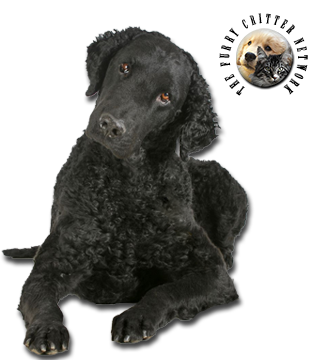Breed Standard
Head: Long. Skull flat and long. Strong jaws. Wide nostrils. Nose black or brown (liver). Lips not pendulous.
Ears: Set on low, small, lying flat against the head, covered with short curls of hair.
Eyes: Large. Black or dark brown.
Body: Rectangular build. Neck moderately long, without dewlap. Chest well let-down. Well-sprung ribs. Short loin.
Tail: Moderately short, carried straight, covered with curly hair, tapering toward the tip, never carried gaily or curled.
Hair: A mass of crisp, tight curls covering entire body.
Coat: Black or brown (liver).
Size: Dog: 68.5 cm. (27 in).Bitch: 63.5 cm. (25 in).
Weight: 30 to 25 kg (66-77 lb).
History
The Curly-Coated Retriever, the oldest of the English retrievers, is believed to be descended from a cross between the Newfoundland and the Irish Water Spaniel. The Poodle and the Labrador may also have contributed to the breed. He was shown for the first time in 1860. A breed club was founded in 1896, and the standard was established in 1913. In the mid-nineteenth century in England, he was more popular as a pet than as a hunting dog. Today, the breed is very limited in number except in a few countries, including New Zealand.
Behavior
The Curly-Coated Retriever was originally developed as a gamekeepers gun dog and their temperament and conformation reflect this purpose. Curlies are still used in many countries as bird hunting companions, including in both upland and waterfowl hunting. Like most retrievers, they are valued as pets and are a lively and fun-loving breed. As long as the Curly has enough exercise, it can be calm and laid back in the home environment, which makes them both a great activity dog as well as a placid member of the family.
The Curly can be sometimes aloof with strangers but are usually very loyal and affectionate with their owners and family. Curlies are extremely intelligent in general, but training can sometimes be difficult as they can easily get bored with repetitive training.
The Curly-Coated Retriever likes exercise; it was bred for athleticism and endurance in the field. A Curly is an intelligent dog and is happiest when it has adequate exercise, mental stimulation and play. Curlies are great dogs for active sports such as hunt tests, flyball and dog agility trials as they love the outdoors, working with people, and activities of any kind. While active and exuberant outside, at play, or in the field, the adult Curly is generally a calm house dog. According to the International Encyclopedia of Dogs (1984), "this dog's delight is swimming", which has made it a valuable retriever especially where streams and rivers have to be crossed.
He is not suited to city life because he needs lots of exercise. He does not like being confined or left alone. He must be brushed twice weekly.
Function
Hunting Dog, Pet.
Health
Known medical issues:
Cancer
Cardiac problems
Epilepsy
Exercise-induced collapse
Eye problems such as cataracts, corneal dystrophy, distichiasis, entropion, ectropion, or retinal dysplasia
Gastric dilatation volvulus (bloat)
Glycogen storage disease (GSD)
Hip dysplasia






